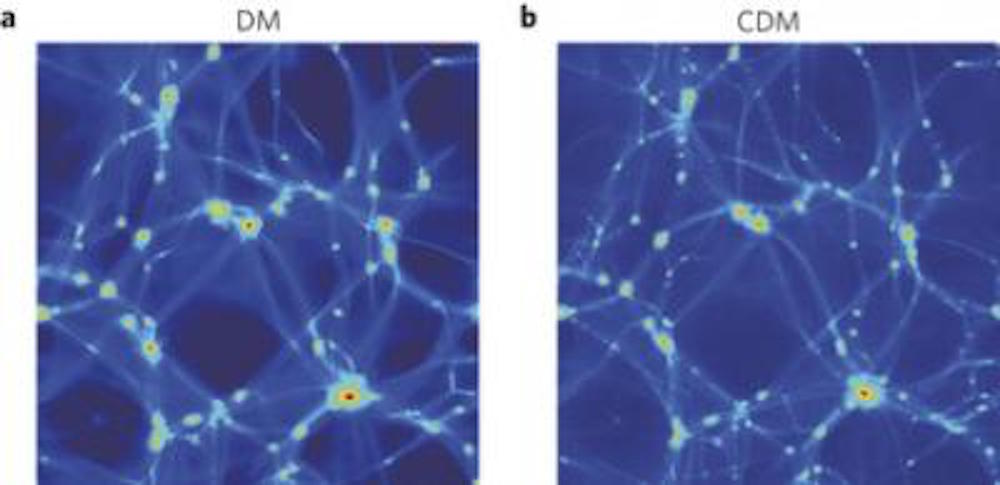Dark Matter's New Wrinkle: It May Behave Like Wavy Fluid

The mysterious dark matter that makes up most of the matter in the universe may behave more like wavy fluids than solid particles, helping to explain the shapes of galaxies, a new study suggests.
Dark matter is one of the greatest mysteries in the cosmos. It is thought to be an invisible and mostly intangible substance that makes up five-sixths of all matter in the universe.
The scientific consensus is that dark matter is composed of a new type of particle, one that interacts very weakly with all the known forces of the universe and is mostly only detectable via the gravitational pull it exerts. However, what kind of particle dark matter consists of remains unknown. [Gallery: Dark Matter Throughout the Universe]
There are two known types of particles in the universe, fermions and bosons. Fermions include particles such as protons, neutrons and electrons, while bosons include particles such as the photons that make up light.
The mainstream focus for dark matter has been on massive fermions, said study co-author Tom Broadhurst, a cosmologist at the University of the Basque Country in Spain. However, so far these fermion candidates for dark matter have not been generated by the Large Hadron Collider (LHC), the most powerful particle accelerator on Earth, nor have any been confirmed by the Large Underground Xenon (LUX) experiment, the most sensitive dark-matter detector ever built.
As a result, some researchers have suggested that dark matter might not be made of extremely high-mass heavy fermions, but low-mass light bosons instead. For instance, Broadhurst and his colleagues investigated the behavior of a boson with a mass of less than 10^-22 electron-volts, or less than a tenth of a billionth of a billionth of billionth the mass of an electron.
The difference between fermions and bosons is that a fermion cannot occupy the same state at the same time as another fermion. As an analogy, a state is like a seat, and two or more fermions cannot sit in the same seat simultaneously. In contrast, two or more bosons can occupy the same state at the same time, and can therefore clump into so-called Bose-Einstein condensates that act like single blobs.
Get the Space.com Newsletter
Breaking space news, the latest updates on rocket launches, skywatching events and more!
Now, Broadhurst and his colleagues have for the first time simulated what galaxies might look like if dark matter was made of light bosons. They said their models more accurately reflect what galaxies actually look like than more conventional models where dark matter is made of fermions.
The researchers investigated dwarf spheroidal galaxies, the smallest and most common class of galaxy, which have centers with masses equal to about 10 million suns. The basic properties of dwarf spheroidal galaxies are very difficult to explain with simulations in which dark matter is made of heavy fermions; these models suggest that much smaller galaxies should exist than what astronomers see, and that dark matter in dwarf spheroidal galaxies should be much less smoothly distributed than what is observed.
Broadhurst and his colleagues simulated the way the gravitational pull of dark matter Bose-Einstein condensates influences the evolution of galaxies. They found these simulated blobs of dark matter led to galaxies that better matched the ones that astronomers see.
The scientists found these dark matter Bose-Einstein condensates are full of waves. Stable waves known as soliton waves are expected in the middle of galaxies, "surrounded by extended lumpy halos of dark matter comprised of giant quantum density fluctuations that fluctuate over time," Broadhurst said. This behavior can help explain both the size of the dwarf spheroidal galaxies seen and why dark matter is distributed relatively smoothly within them.
Another consequence of dark matter Bose-Einstein condensates is that galaxy formation should have begun about 330 million years after the Big Bang. This is substantially delayed compared to models that envision dark matter being made of fermions, which suggest that galaxy formation should have begun about 50 million years after the Big Bang. Future observations by NASA's Hubble Space Telescope could help determine whether dark matter consists of fermions or bosons, study team members said.
Broadhurst and his colleagues Hsi-Yu Schive and Tzihong Chiueh detailed their findings in June in the journal Nature Physics.
Follow us @Spacedotcom, Facebook or Google+. Originally published on Space.com.
Join our Space Forums to keep talking space on the latest missions, night sky and more! And if you have a news tip, correction or comment, let us know at: community@space.com.

Charles Q. Choi is a contributing writer for Space.com and Live Science. He covers all things human origins and astronomy as well as physics, animals and general science topics. Charles has a Master of Arts degree from the University of Missouri-Columbia, School of Journalism and a Bachelor of Arts degree from the University of South Florida. Charles has visited every continent on Earth, drinking rancid yak butter tea in Lhasa, snorkeling with sea lions in the Galapagos and even climbing an iceberg in Antarctica. Visit him at http://www.sciwriter.us









